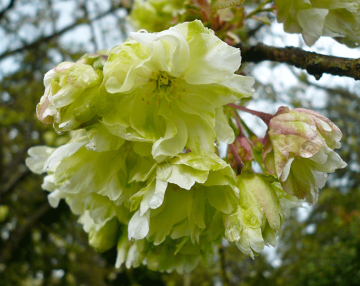March, you say? You’d be excused if you thought this was April. Very much in the same vein as 2015, spring has come exceptionally early to the southwest coast. Barring a sudden cold snap, March is on track to be a spectacular month for flowers and early growth in the Botanical Garden. Perhaps most famously, the Garden has significant collections of magnolias and rhododendrons, both groups well-budded and promising to put on a magnificent show this year.
Another popular group of early spring flowering plants worth mentioning is ornamental cherries. Other than a small number of older specimens‚ including the row of Prunus ‘Tai-haku’ (great white cherry) along Marine Drive at the entrance, the group of P. sargentii (further west along Marine Drive and the superb little P. incisa (Fuji cherry) in the E.H. Lohbrunner Alpine Garden, ornamental cherries have never been particularly prominent in the Garden—that is, until now. With the encouragement of the late David C. Lam and the Vancouver Cherry Blossom Festival, the Botanical Garden made a decision some years ago to embark on a program to preserve the rarest of Vancouver’s cherries. Following on from the propagation work of horticulturists in the Botanical Garden Nursery, students and faculty in the BCIT Biotechnology program, and the generous help of staff at the Vancouver Park Board, we now have access to some of the rarer and more interesting flowering cherries in Vancouver for planting.
Visitors to the garden can now meander though the Wharton Cherry Grove to the west of the parking lot at the Garden’s entrance. There’s a mixture of cultivars in this area, including both traditional Japanese Sato-zakura (village cherries) and modern cherries. Our first to flower is the deep, vivid-pink, Prunus subhirtella ‘Whitcomb’, a Japanese “spring cherry” seedling originally selected in Seattle. Hard on its heels in bloom sequence is an strongly upright hybrid cherry, ‘Umineko’. The name means “seagull” in Japanese and refers to the pure white flowers. The most unusual of the cherries in the Wharton Grove is a pair of ‘Gyoiko’ cherries. A classic sato-zakura known from before 1780 in Japan, Prunus ‘Gyoiko’ has subtly purple-red-streaked green-and-white flowers, the outer petals mostly green and the inner petals variously green-striped. The depth of colour in its flowers is accentuated by mild winter temperatures and the name refers to the richly coloured, white, green and purple robes of female courtiers in ancient imperial Japan.

Prunus ‘Gyoiko’
The propagation method used for this project was simple summer stem cuttings, while micropropagation (tissue culture) was employed for the more difficult to root cultivars. Growing these trees on their own roots (as opposed to the usual approach of grafting onto a European sweet cherry rootstock) allows the trees to express to a greater degree their natural character, such as low, less dense branching and slow growth. Compare, for example, the young trees in the Wharton Grove with the more typical looking grafted trees along Marine Drive. There are plans to accommodate more ornamental cherries in the Garden, and with the guidance of Nitobe Memorial Garden’s curator, Ryo Sugiyama, to begin to replace the diseased and moribund cherries at Nitobe, and to add to that collection. Two exceptionally rare Sato-zakura at Nitobe—Prunus ‘Ojochin’ (the lantern cherry) and P. ‘Taki-nioi’ (fragrant waterfall) have been successfully propagated. In the Vancouver area (and probably the rest of Canada) ‘Taki-nioi’ is only known from the single tree at Nitobe, and ‘Ojochin’ from Nitobe and a venerable specimen in Stanley Park. ‘Taki-nioi’ usually blooms in April, but this year, visitors should be able to see and smell its beautiful, almond-scented flowers near the end of this month. Whether you visit Nitobe Memorial or the Botanical Garden in March, you’re sure to see some spectacular flowers, whether from new saplings or established trees.
More pictures of March in the Garden can be found in our Forums.
Submitted by Douglas Justice, Associate Director of Horticulture and Collections, March 4, 2016
